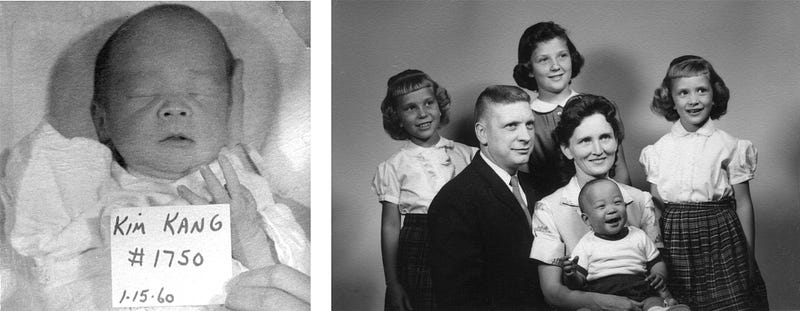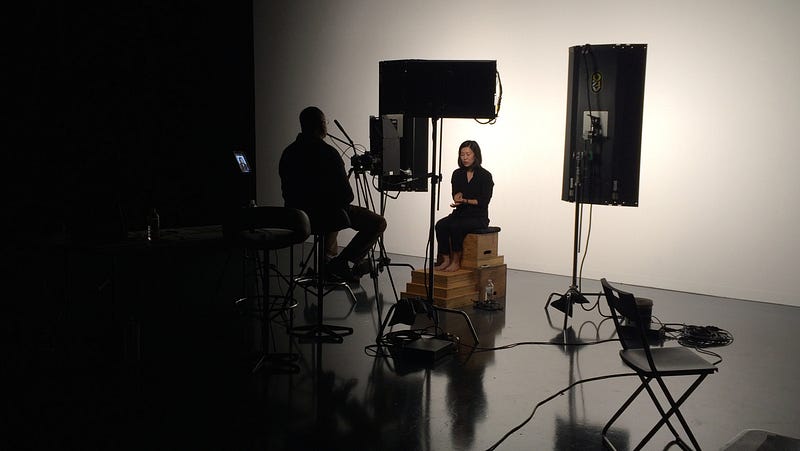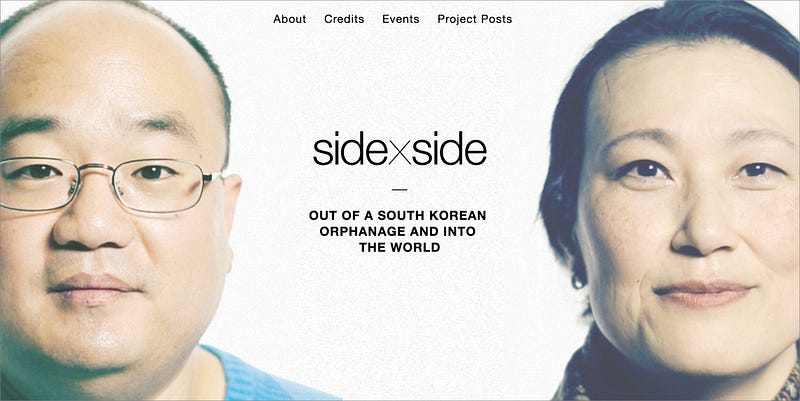 The
sidebysideproject.com — 100 first-person narratives of abandonment, relinquishment, orphanages,
aging out, and inter-country adoption from South Korea
The
sidebysideproject.com — 100 first-person narratives of abandonment, relinquishment, orphanages,
aging out, and inter-country adoption from South KoreaThe multi-platform depiction of 60+ years of adoption out of South Korea.
This story starts in the 1950s, during and after the Korean War. At the time, two million infants and children had been orphaned or somehow separated from their families of origin: Rounded up from the streets, found abandoned in doorways, police stations, and churches. Distributed to orphanages, to live side-by-side in rows of sleeping mats, boxes, and cribs.
It didn’t end there. The steady stream of homeless children continued unabated through the post-war decade, the decades of political and social instability, the early growth, the IMF bail-out, and even through massive development and international expansion into a global economic force. Still, they were abandoned and relinquished into orphanages, with consequences of hunger and poverty, social stigma and racial bigotry, broken marriages, and untimely death.
Out of millions, some 180,000 were plucked from the orphanages and adopted out, primarily to wealthy Western countries. Most, however, weren’t chosen for adoption or weren’t eligible, and they “aged out” to face the challenges of living in Korea without a family. Others died in the orphanages or on the streets.
The random chaos of the universe. In its fullness.
This is the story that became an improbable, unconventional, multi-platform documentary art project, Side by Side: Out of a South Korean Orphanage and Into the World.
58 years ago, I was an orphan in South Korea.
As a days-old infant abandoned on the streets of Seoul, I was processed through City Hall and placed in an orphanage. Six months later, chosen based on nothing more than a photo of me, I became the first son of an upper-middle class family of five, living in the suburbs of Denver, Colorado.
 From a
Seoul orphanage to a Denver suburb, and from Kim Kang to Glenn Morey
From a
Seoul orphanage to a Denver suburb, and from Kim Kang to Glenn Morey80 of us were on the airplane that took us to America. Hundreds stayed behind. All of which begs a number of rather mind-bending questions:
Why me? What happened to the other 80? What happened to the other 180,000 adopted Koreans over 60+ years? What happened to the millions who aged out? What would my life be if I had stayed in Korea?
Five years ago, we started filming interviews.
We started in South Korea, with eleven ROK nationals who had aged out of orphanages. From there, we filmed interviews with adopted Koreans in eight U.S. cities coast to coast, then on to Stockholm, Copenhagen, Amsterdam, Paris, and Melbourne.
Over the course of 3 years, 7 countries, 6 languages, and 16 cities, we acquired the first-person narratives of 100 orphans and “social orphans” born in South Korea since the 1950s—a diverse representation of millions of infants and children who were somehow separated from their families of origin, institutionalized in orphanages.
 We filmed
interviews in 7 countries, 6 languages, and 16 cities.
We filmed
interviews in 7 countries, 6 languages, and 16 cities.We approached every interview in the same way—loosely structured, first-person narrative sessions in which subjects told us the stories of their lives. In roughly chronological order, they told us what they remembered or what they’d been told about their origins in South Korea. How they were separated from their Korean families of origin. How they were adopted or aged out. How they grew up and came of age. Who they are today.
We quickly began to understand the unimaginable disparity of our subjects, contrasting the stories of the adopted and the aged-out, the nurtured and the abused, the blessed and the broken, the loved and the lost, and the stories that lie between.
We also realized what our subjects were fully prepared to give us — in the human cost and emotional toll of remembering love and loss, in the spontaneous and sometimes searing revelations of the moment. Each session became its own filmic experience, captured as subjects drew on and relived repressed memories, connected events, finally acknowledged truths, resolution, and reconciliation.
We could have filmed many, many more interviews, going to a dozen other countries. We stopped at 100. It’s not a magic number. It was just a way for us to stop.
Early on, we became committed to the belief that somehow presenting every story we filmed was the most honest project we could create.
Typically, filmmakers have to make decisions. Those decisions, especially in the editing room, result in the filmmaker’s interpretation of the topic, told through a limited number of filmed subjects.
This project deserved a different approach. We wanted to find a way to include the many stories required to represent an international and largely unknown subculture, and to allow their telling to be exactly as the tellers intended. We also wanted our audiences to be able to immerse themselves in this subculture, coming to know it and our storytellers intimately.
So with that, our documentary became, not a linear film, but a non-linear, highly unconventional, multi-platform art project.
Side by Side initially takes the form of an online video installation, streaming 100 separate filmed interviews, all of them presented very nearly in their entirety, as they were filmed in a single continuous sitting — a total of 21 hours of available material. Viewing these stories is very different from viewing a conventional movie. With every resurfaced memory, every pause, every revelation, and as every minute goes by, viewers come to know these storytellers in unexpected depth. In our minds, this installation is the purest expression of the project.
 sidebysideproject.com
sidebysideproject.comLater, Side by Side will be released as a starkly minimalist, short documentary film, providing a more easily digestible view of the adoption side, and well-suited for online video streaming platforms, theatrical screening, and limited attention spans. Over the course of just 40 minutes, audiences will come to know nine adoptees — in Seattle, Chicago, New York City, Boston, Stockholm, Amsterdam, Paris, and Melbourne — as they face revelations about their origins and struggle to make sense of their lives.
Side by Side is being built into a curated, 10-screen, video art installation, featuring 10 short documentaries, each focused on an emergent theme from the interview sessions. As essentially a non-linear, immersive guided tour through over 5 hours of film, it is the right presentation for museum visitors, and will be placed in art, cultural, community, and educational institutions in the U.S. and abroad.
Related articles and syndicated content will allow for expanded context and understanding of the topic, with experts in child and adolescent psychiatry, the psychology of identity, social work, and sociology. Lastly, the interview transcripts, along with portraits of each subject, will be adapted into a book — allowing more physical tangibility and permanence, in a digital world.
In total, we envision five platforms, with five very different adaptations to fit the characteristics of each venue.

“The danger of a single story.”
Along the way, we’ve been inspired by Chimamanda Ngozi Adichie, author of Americanah, among numerous other novels and stories. Her views on “the danger of a single story,” compellingly articulated in her 2009 TED Talk, helped immensely in shaping the narrative of Side by Side. Perhaps even more importantly, her words gave us faith, as we watched this project get bigger and bigger.
But is multi-platform art even a thing? We have no real idea how people will react to its unconventionally large scale and multiple forms. Maybe this is just a good way to portray random chance. Maybe it’s the only way.
Glenn and Julie Morey are a husband/wife filmmaking team. Glenn (AKA Kim Kang) was born in Seoul, South Korea, in 1960. He was abandoned days after birth, taken to Seoul City Hall, then to a Holt orphanage, and adopted at the age of six months to the US. They both have long careers as award-winning commercial and documentary filmmakers, and live in Denver as empty-nesters, but with adopted cats. Contact: Glenn Morey, gm@glennmorey.com, sidebysideproject.com.
Immerse is an initiative of the MIT Open DocLab and The Fledgling Fund, and is fiscally sponsored by IFP. Learn more about our vision for the project here.